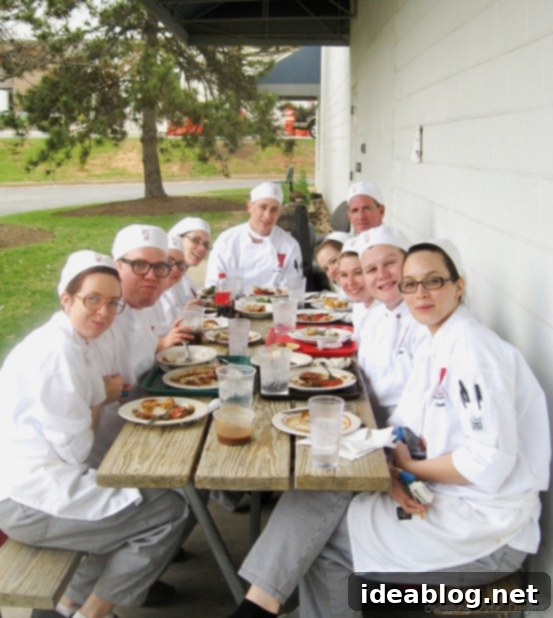Behind the Scenes of a Six-Course Culinary Banquet Challenge: Precision, Pressure, and Passion
Today marked a significant milestone in our culinary journey: the highly anticipated banquet challenge. This intensive exercise tasked us with creating a sophisticated six-course meal designed to impeccably serve 75 people within our school community. The guest list included not only our peers from Phase I and II pastry and culinary programs but also our esteemed teachers and the dedicated front-of-house staff. The entire monumental undertaking was completed in just under four hours, demanding extreme speed and unwavering focus. Despite the high-pressure environment, it was an incredibly rewarding and exhilarating experience, pushing our skills to their limits and fostering an unparalleled sense of teamwork.
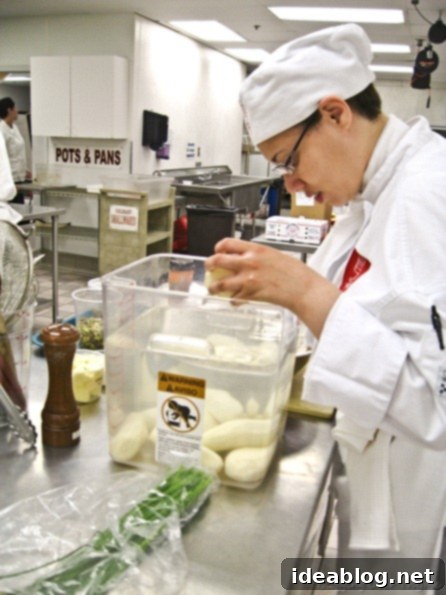
My partner for the day, Tasha, diligently counting her peeled potatoes—all 25 of them, crucial for our ambitious first course!
The preparation for this grand event began even before the challenge day itself. The day prior, we had the unique opportunity to volunteer for specific dishes, allowing us to step outside our regular team pairings and choose a course that truly ignited our culinary interest. My best buddy, Tasha, and I shared an immediate consensus: we both eagerly opted for the canapé and the first-course dish. Our decision was primarily driven by the sheer deliciousness of the dishes themselves, but also by a strategic foresight. We recognized that completing our components earlier in the service would free us up to assist our classmates with the subsequent courses, ensuring a smoother overall operation for the entire banquet. This spirit of collaboration is a cornerstone of professional culinary training, and the banquet challenge exemplified its importance.
This morning, the bustling energy in the kitchen was palpable. We received a concise yet critical briefing on all the dishes, ensuring everyone understood their roles and the precise timing required. Chef Patrice, with his characteristic flair, then provided an inspiring demonstration of our mid-course amuse-bouche: a vibrant Grapefruit Tarragon Champagne granite. This exquisitely refreshing shaved ice concoction was not only a delight to taste but also served as a perfect palate cleanser. Its preparation, with its delicate balance of sweet and herbaceous notes, set a high standard for the day’s culinary artistry. Following the demo, there was no time to spare; we immediately plunged into the organized chaos of the kitchen, ready to transform raw ingredients into a culinary masterpiece.
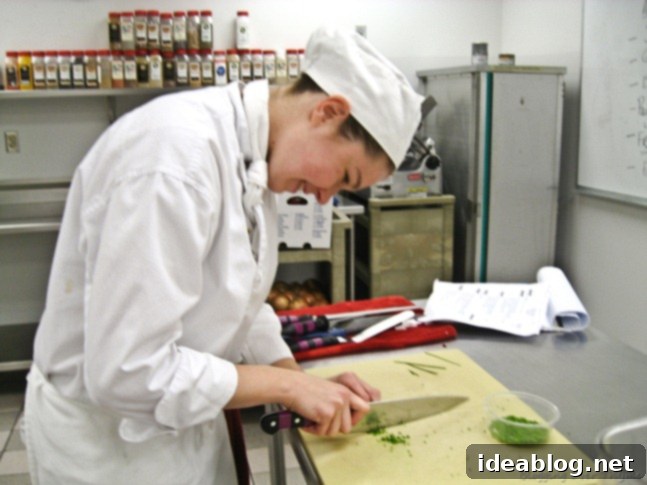
The essential first step: meticulously preparing our Mise En Place and precisely chopping chives, critical for flavor and presentation.
Our designated course involved a dual responsibility. First, we crafted a delicate duck pâté canapé, elegantly served on crisp croutons. While the rich duck pâté itself had been prepared in advance, our task encompassed the crucial steps of meticulously preparing the croutons, assembling each canapé with precision, and finishing them with a glistening aspic layer and a tiny cornichon garnish. This seemingly small task required immense attention to detail, as canapés set the first impression of the meal. The contrast of the savory pâté with the crunchy crouton and the slight tang of the cornichon created a delightful opening bite.
However, our primary focus and indeed the most demanding part of our contribution was the exquisite first course: house-smoked salmon, artfully presented on a delicate potato crust, accompanied by creamy goat cheese and garnished with finely chopped hard-boiled eggs, briny capers, and sharp red onions. This was served alongside a fresh green salad, elevated by the addition of caramelized pistachios. The salmon, a testament to intricate preparation, had been cold-smoked in-house a few days prior, ensuring its rich, nuanced flavor. Despite its elegant description, executing this dish for 75 people plus an additional 10 “over-runs” (always prepared for good measure in a professional kitchen) meant non-stop, high-intensity work to meet the noon deadline. Every component, from the salmon’s perfect texture to the precise seasoning of the goat cheese, had to be flawless.
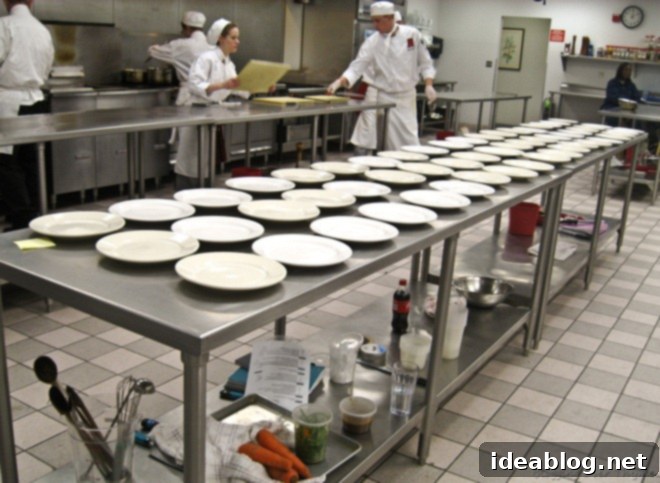
The kitchen expertly cleaned up and all the plates meticulously set up, awaiting the first course of the grand banquet!
Undoubtedly, the most time-consuming and challenging aspect of our dish was the creation of the potato crusts, known in French culinary tradition as “pommes darphin.” We needed to produce a staggering 25 individual crusts, each requiring meticulous attention. Pommes darphin is a dish we’ve practiced extensively in Phase I, even featuring on our second exam. For this banquet, we made them considerably thinner than usual, designed to serve as a delicate yet sturdy base for the smoked salmon and goat cheese. The process demands a keen eye, a precisely temperature-controlled pan, a generous amount of clarified butter for that perfect crispness, and expert, careful flipping to ensure even cooking and a beautiful golden-brown finish without burning. Each crust is a labor of love, requiring patience and precision.
The inherent challenge with potatoes, once julienned with a mandoline, is their rapid oxidation – they turn grey almost instantly if exposed to air. (On a side note, it’s worth mentioning how dangerous a mandoline can be if not handled with extreme care; thankfully, neither Tasha nor I had any mishaps!). To combat this, Tasha and I worked in tandem, managing about five small pans of these potato “pancakes” at the stove simultaneously, constantly adjusting heat and flipping, while the other would rush back to the preparation table to shred fresh batches of potatoes. This intricate dance was necessary to prevent discoloration and ensure a consistent product. Even with our coordinated efforts, producing all 25 flawless pommes darphin was an arduous, *long* process that tested our endurance and synchronization. We knew that consistency was key, and any deviation in texture or color would be immediately apparent on the plate.
Just when we thought we were nearing completion, a frustrating setback occurred. We discovered that a significant portion of our completed pommes darphin, which we were holding warm in the oven, had unfortunately overcooked. They weren’t entirely ruined, but they had become a touch too crispy and excessively browned, deviating from the delicate texture we aimed for. This mishap, likely due to a miscommunication regarding oven temperatures, meant we had to undertake the daunting task of re-making almost half of them from scratch. In a high-stakes, time-sensitive environment like a banquet challenge, such a setback can feel devastating. However, the experience taught us resilience and adaptability. Against all odds, fueled by adrenaline and sheer determination, we somehow managed to get all the crusts re-made and ready just in time for service, a true testament to our training and teamwork.
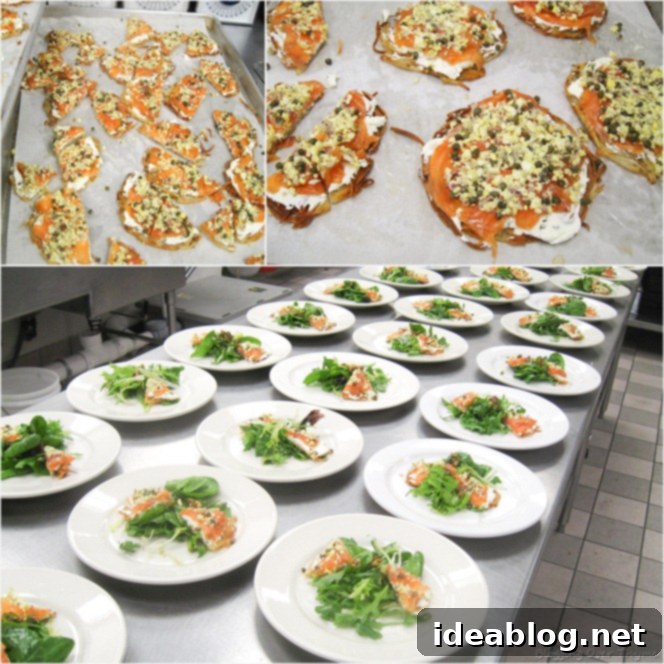
Once the delicate potato crusts had cooled sufficiently, we moved swiftly to the assembly phase. Each crust was generously spread with our meticulously prepared goat cheese mixture, which we had seasoned to perfection with finely chopped chives, minced garlic, and a balanced blend of salt and pepper. This creamy, tangy layer provided a wonderful counterpoint to the rich smoked salmon, which was then carefully placed on top. The final artistic touches included the intricate garnishes – the chopped hard-boiled eggs, capers, and red onions – adding both visual appeal and a burst of complementary flavors. To facilitate elegant serving alongside the green salad, we then expertly sliced these culinary creations into small, perfectly proportioned triangles. The combination was utterly divine; the harmonious blend of textures and tastes was truly satisfying, making all the hard work worthwhile. So delicious, hmmm…
During the intense service period, our entire class transformed into a highly efficient culinary machine. Under Chef Patrice’s expert direction, guiding us on optimal placement and organization, we operated at two separate plating stations, forming a seamless assembly line. This orchestrated chaos was crucial for getting every dish out to the 75 guests as swiftly and impeccably as possible. For the green salad, in a testament to efficiency and practicality, we all donned sterile gloves. This allowed us to quickly dress multiple bowls of fresh salad and dish it out with our hands, ensuring rapid service. It was a method far quicker and more streamlined than using tongs, particularly when speed and consistency are paramount.
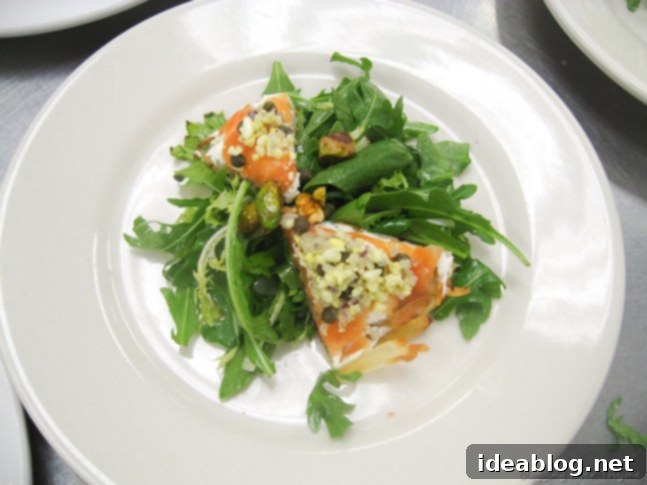
While I was engrossed in my own course, I regret that I can’t delve into the precise cooking details of the other banquet dishes, as I wasn’t personally involved in their preparation. However, I can attest with absolute certainty that every single course was executed beautifully and tasted absolutely delicious! The quality and creativity displayed by my classmates were truly impressive.
Our second course, masterfully prepared by Hannah and Lyndsay, showcased a delectable bacon-wrapped monkfish. This firm, lean fish was seared to perfection, offering a beautiful crust and tender interior. It was elegantly served atop a bed of earthy French lentils, complemented by a luscious Beurre Blanc sauce – a classic emulsion of butter, shallots, and white wine vinegar – and adorned with a delicate fried beet garnish, adding a touch of color and subtle sweetness.
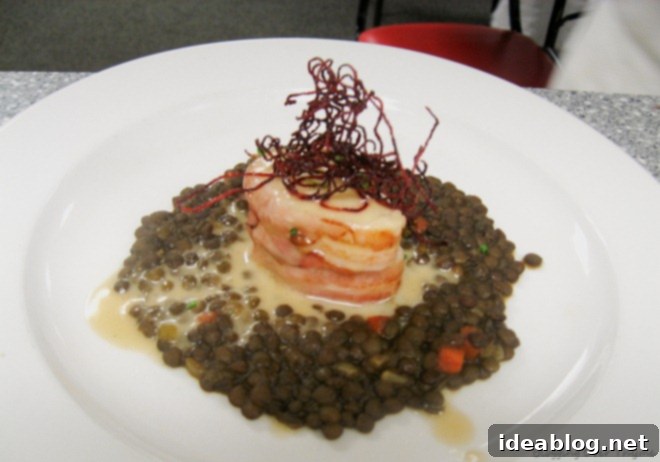
Following the savory monkfish, our refreshing grapefruit tarragon champagne granite made its timely appearance. We had meticulously prepared this palate cleanser earlier and held it perfectly chilled in the freezer, ready for service. The ingenious aspect of serving a savory amuse-bouche of this nature is its practical benefit: it skillfully buys the kitchen a crucial window of time. This brief interlude allows the team to calmly and precisely finalize the preparations for the main course, ensuring that the elaborate primary dish can be presented with the utmost care and perfection. This strategic pacing is a hallmark of fine dining service, and it proved incredibly helpful in maintaining our smooth flow.
The main course was a true showstopper: a tender, flavorful roasted lamb shoulder. This exquisite cut of lamb had been expertly deboned, then generously rubbed with a fragrant blend of harissa, cumin, and Raz El Hanout – a complex and aromatic Moroccan spice blend known for its floral, sweet, and savory notes. It was slow-roasted to achieve incredible tenderness and depth of flavor. Accompanying this magnificent centerpiece was a charming petite ratatouille, artfully served nestled within a roasted tomato, adding both color and a burst of Mediterranean freshness. The plate was further enhanced by velvety pommes dauphinoise, a rich gratin layered with thinly sliced potatoes, infused with savory Parmesan and Gruyère cheeses, and tender cooked leeks – truly a comforting and luxurious side. Completing the ensemble were crisp green beans, elegantly bundled and wrapped with a delicate ribbon of blanched carrot, showcasing an impressive attention to detail and presentation. I barely managed to snag a quick picture of this culinary marvel before it was whisked out of the kitchen to eager diners!
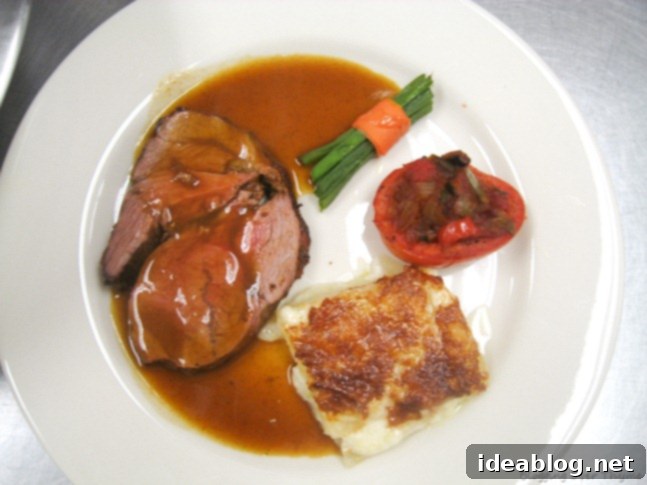
Finally, to culminate this spectacular meal, we served a warm and inviting Apple Brioche Pudding. This comforting dessert was bathed in a rich Bourbon Caramel Sauce, offering a delightful depth of flavor. It was presented with exquisite spun sugar décor, adding a touch of delicate artistry, and a perfectly formed quenelle of ethereal whipped cream, providing a creamy, light contrast to the warm pudding. This dessert was more than just a sweet ending; it was a nostalgic treat.
I distinctly remember savoring this very pudding during Phase I of our training, and it was every bit as delightful as my memory served. Its texture was wonderfully moist, its richness perfectly balanced without being overly sweet, making it an utterly satisfying conclusion to the banquet. This is definitely a recipe I’ll be revisiting and making again in my future culinary endeavors, a testament to its enduring appeal and classic deliciousness.
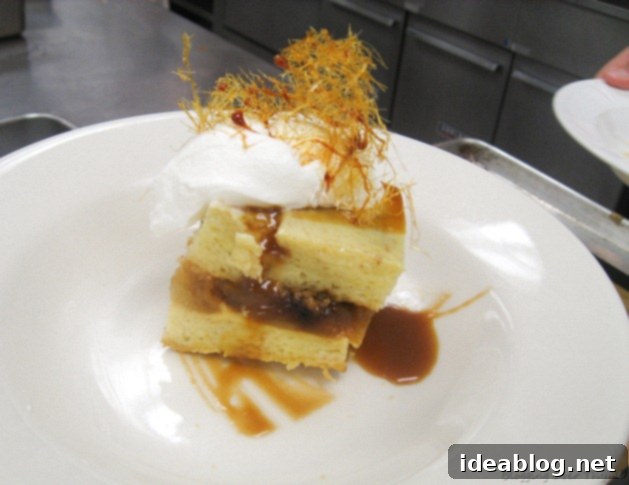
Overall, the banquet challenge represented a truly refreshing change of pace from our usual daily routines. The opportunity to work and plate as an entire class, with every student contributing to a single, grand objective, was an invaluable experience. The atmosphere felt remarkably more cohesive, incredibly organized, and, above all, immensely fun. It was a profound lesson in collective effort and synchronized execution.
Moreover, there was an immense sense of gratification in witnessing how all ten of us, as a tight-knit culinary unit, could collaborate so effectively to cook and serve such an elaborate meal to so many people within such a stringent timeframe. It highlighted our collective growth and capability as aspiring chefs.
After the last course was served and the immediate flurry of service subsided, we had the distinct pleasure of being able to sample every single dish from the banquet. Our small class then gathered outside at the picnic table, where we could finally relax, reflect on our achievement, and truly savor the delicious “fruits of our labor.” It was a moment of well-deserved camaraderie and enjoyment, a perfect culmination to a challenging yet rewarding day. Luckily, with our class being so wonderfully compact, we all fit comfortably around the table, sharing stories and laughter. Fun times indeed!
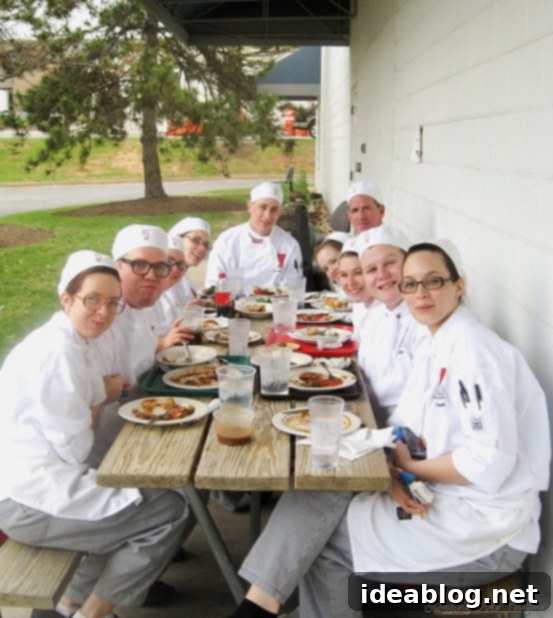
Tomorrow, it’s back to our usual routine and working in our familiar teams of two. However, the excitement doesn’t end there! We will also be receiving the mystery ingredients for our highly anticipated second Market Basket Challenge. This will be our first official, “real” Market Basket, significantly more complex and demanding than our initial practice runs. This particular challenge, scheduled for Friday, holds even greater weight as it will be judged by a distinguished visiting chef. The anticipation is mounting, and I must admit, I’m already feeling a mix of nerves and exhilaration!
